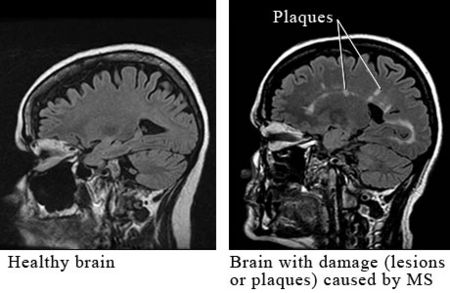Multiple sclerosis
From Proteopedia

Multiple sclerosis (MS) - an autoimmune disease that effects every patient differently based on the neurologic lesions inflicted throughout the body. While some can go through their lives with relatively mild symptoms and short periods of relapse, others can become incapacitated within years or even months. Defined by Nylander and Hafler, MS is a "multifocal demyelinating disease with progressive neurodegeneration caused by an autoimmune response to self-antigens in a genetically susceptible individual."[2] Inflammation is the primary cause of damage in MS, and though the effects of the disease are well known, and various treatments exist for the disease, the exact identity of an antigen or infectious agent that causes the initiation of a myriad of symptoms is unknown.[3]
There are three ways in which MS is categorized: relapsing-remitting (RRMS), secondary progressive (SPMS), and primary progressive (PPMS). In RRMS, the patient experiences periods of time in which the symptoms increase considerably, although the neurological function of the patient usually returns to normal after the episode. Those with SPMS have symptoms like RRMS, but do not return to normal neurological function after the episode, rather they sustain the neurological damage (such as permanently losing the use of an arm). In PPMS, the patient has an initial episode that never ends. That is, once the symptoms begin, there is no remission in the neurological degradation. A constant autoimmune attack on the patient's body causes increasingly severe symptoms, which can sometimes lead to death.
Taking a biochemical look at the immunopathology and some of the various treatments that exist for MS helps in the understanding that MS is no longer a diagnosis which is hopeless, but is in fact full of hopeful and helpful treatments.
| |||||||||||
References
- ↑ [1] Poinier, A.C., Husney, A., and Chalk, C. "Magnetic resonance imaging (MRI) of multiple sclerosis." Health.com Updated: 2010 Feb 18.
- ↑ 2.0 2.1 2.2 Nylander A, Hafler DA. Multiple sclerosis. J Clin Invest. 2012 Apr 2;122(4):1180-8. doi: 10.1172/JCI58649. Epub 2012 Apr 2. PMID:22466660 doi:10.1172/JCI58649
- ↑ Loma I, Heyman R. Multiple sclerosis: pathogenesis and treatment. Curr Neuropharmacol. 2011 Sep;9(3):409-16. PMID:22379455 doi:10.2174/157015911796557911
- ↑ Dziedzic T, Metz I, Dallenga T, Konig FB, Muller S, Stadelmann C, Bruck W. Wallerian degeneration: a major component of early axonal pathology in multiple sclerosis. Brain Pathol. 2010 Sep;20(5):976-85. Epub 2010 Apr 14. PMID:20477831 doi:10.1111/j.1750-3639.2010.00401.x
- ↑ Smith KJ, Lassmann H. The role of nitric oxide in multiple sclerosis. Lancet Neurol. 2002 Aug;1(4):232-41. PMID:12849456
- ↑ Campbell GR, Ziabreva I, Reeve AK, Krishnan KJ, Reynolds R, Howell O, Lassmann H, Turnbull DM, Mahad DJ. Mitochondrial DNA deletions and neurodegeneration in multiple sclerosis. Ann Neurol. 2011 Mar;69(3):481-92. doi: 10.1002/ana.22109. Epub 2010 Nov 8. PMID:21446022 doi:10.1002/ana.22109
- ↑ Mosyak L, Wood A, Dwyer B, Buddha M, Johnson M, Aulabaugh A, Zhong X, Presman E, Benard S, Kelleher K, Wilhelm J, Stahl ML, Kriz R, Gao Y, Cao Z, Ling HP, Pangalos MN, Walsh FS, Somers WS. The structure of the Lingo-1 ectodomain, a module implicated in central nervous system repair inhibition. J Biol Chem. 2006 Nov 24;281(47):36378-90. Epub 2006 Sep 27. PMID:17005555 doi:M607314200
- ↑ Voet, D., Voet, J.G., and C. Pratt. Fundamentals of Biochemistry 3rd Edition. Hoboken, NJ: John Wiley and Sons, 2008. Print.
- ↑ Kudo M. Management of hepatocellular carcinoma: from prevention to molecular targeted therapy. Oncology. 2010 Jul;78 Suppl 1:1-6. Epub 2010 Jul 8. PMID:20616576 doi:10.1159/000315222
- ↑ http://www.uniprot.org/uniprot/P00784
- ↑ [2] Samuel, C.E. "Interferons, Interferon Receptors, Signal Transducer and Transcriptional Activators, and Inteferon Regulatory Factors." J Biol Chem 2007 282: 20045-20046. First Published on May 14, 2007, doi:10.1074/jbc.R700025200
- ↑ Chill JH, Quadt SR, Levy R, Schreiber G, Anglister J. The human type I interferon receptor: NMR structure reveals the molecular basis of ligand binding. Structure. 2003 Jul;11(7):791-802. PMID:12842042
- ↑ Quadt-Akabayov SR, Chill JH, Levy R, Kessler N, Anglister J. Determination of the human type I interferon receptor binding site on human interferon-alpha2 by cross saturation and an NMR-based model of the complex. Protein Sci. 2006 Nov;15(11):2656-68. Epub 2006 Sep 25. PMID:17001036 doi:10.1110/ps.062283006
- ↑ 'MS:Pathogenesis and Treatment'
Relevant 3D Structures
Interferon Beta
1au1 - Homo sapiens
Interferon Receptors
3s98, 3se3, 3se4, 1n6u, 1n6v, 2hym, 2kz1, 2lag, 3s8w, 3s9d - Homo sapiens
